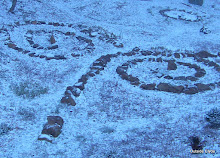The high today of 48 degrees was all that could be mustered by the end of the day. It will be colder tomorrow than the low of 40 this morning. I go outside regularly to acclimate.

This guy must have been blown out of the trees by the zippy cold winds. I hope it gets a chance to pupate before it is too late. I remember these from my childhood, but would have to look it up to find out what it will metamorphose into.

Looking closer at the strange fern that was sending up new growth, I found that this is the fruiting stem. When I flicked it, it gave off a small cloud of yellow spores.

It looks like there could be two leaf forms or once again in the world of dozens of similar species there is more than one kind of them.

The Rattlesnake Plantain, Goodyera pubescens was the first orchid species identified on this land. (Unless, now that I am making a link it is Goodyera repens, the dwarf species.) I am pretty sure the new leaf emerging in the previous post is the Aplectrum hyemale after taking another look and which I found more of on this side of the property line. That is a good thing since the book I am using to ID them says moving these orchids is a losing proposition. I would not be adverse to spreading their seed pods around though. The resident gardeners tell me that Showy Orchis, Galearis spectabilis, a third orchid can be found up here too.

Come spring time I will be counting the violets.
Other things must come first. Those clouds this morning looked like they just might be packing some snow and we haven't done our official first frost.

Brrrrrr!






11 comments:
Yeah, that nose dripping thing is annoying. Happy to hear you are acclimating. 48 is definitely cold for this time of year. Mixed up 'ol weather!
Wait till it gets really cold! Wait, how cold does it get there? You're not going below zero, are you?
That's why I don't buy jackets without pockets - because we do have some 40's each year.
It seems so soon for snow and cold already, Christopher!
Annie
How cold does it get? Well I have down rated my zone to a 5b because of the 4000' elevation which is a MINUS -10 to -15 degrees average annual minimum temperature. The resident gardeners have confirmed this low.
Now this being the south, it is a hit or miss kind of cold that blows in with the fronts and only lasts for a few days. I would suspect that on average it will be in the low 50's for the high and 30's to 20's for the lows. I hope!
Yes Annie a new coat with pockets for tissue wads.
The good news is this:
Low forties is cold, but sort feels the same "coldness" down to anout 25*F. The only difference being ice. My April I am thrilled for a 30*F day and don't even need a coat.
The teens to below zero are, to me, a different sort of misery that are all the same. 15 degrees is the same to me as -5.
So, why is this good news? Because it means that we can have "warm" (relatively) days in winter.
Up here, the earth freezes hard. Big problems. Dig your holes amd trenches NOW. (I don't know about don't there.)
Also, I need a mailing address for you. I have a seed/bulb care package of some extra stuff.
hank@heatly.com
Oh wow... are those leaves with the white stripe down the middle your showy orchis? I am unfamiliar with them, but am struck by the beauty of those leaves and the way they grow in handsome swirls.
donde esta la upright rebar for the wall ?
brrrrrrrr. sounds like it is getting very very cold.
So Hank there is cold and then there is COLD! Good to know.
Kim that white center striped leaf with the white veining is the Rattlesnake Plantain, Goodyera pubescens. There is a lot of that up here.
No no erecto rebar in el wall.
It will be about 42" tall, made of the stone on site, mortared into place. The footing has a slight lean into the hill, as will the wall. I will be using, don't know the proper term, but locking stones, rocks that run perpendicular to the wall and are embedded into the hill. Drainage PVC will be placed in the wall too.
S'all right?
Oh and don't do cement work when there is danger of freezing within 48 hours.
Chris,
as you have probably figured out we tend to over build here in earthquake country.
In my neck of the woods we would require additional rebar to extend up into the stone wall for tensile strength.
Building techniques in your neck of the woods may be a bit more lax due to your stability .
The soil here can easily liquify with an earthquake and having a wall that has some flexibility is a good thang.
We also tend to have highly expansive clay soils and a very heavy rainy season so planning/ engineering for hydrostatic pressure is important... just as important as planning for drainage.
Your dad probably knows the common building practices for walls in your new area.
I'd depend on local info rather than long distance Kal- i-for-na-ca building techniques.
Here is a link to a new post I put on my blog showing how we build rock walls here in N. Cal.
http://deviantdeziner.blogspot.com/
Michelle, if you saw how they built walls in Maui where we do have occasional mild earthquakes, you would freak. They often had no footing and never had any steel, in a footing if there was one and definately not rising up into the wall, stone or cmu.
It is good to know best build practices though.
Post a Comment